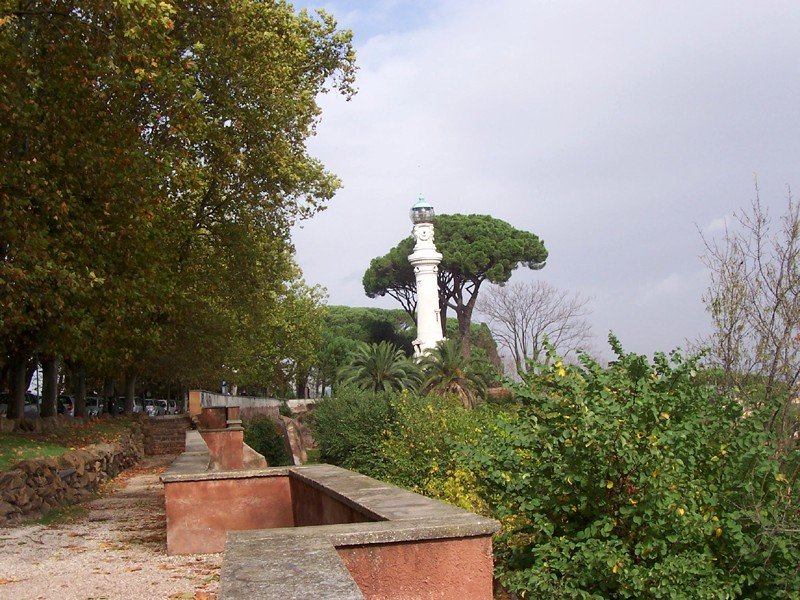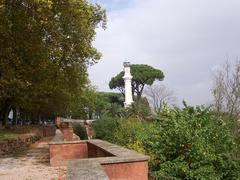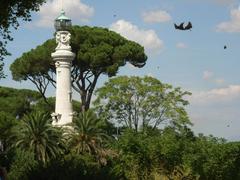
Comprehensive Guide to Visiting Faro di Roma, Rome, Italy
Date: 17/08/2024
Introduction
Faro di Roma, also known as the Lighthouse of Rome or Faro del Gianicolo, is a captivating historical and cultural landmark perched atop Janiculum Hill. Established in 1924, this monument was a gift from the Italian community in Argentina to commemorate the 50th anniversary of Italy’s unification, symbolizing guidance, unity, and resilience. Today, it stands as both an architectural marvel and a vibrant public space, offering breathtaking panoramic views of Rome and the Vatican City, hosting cultural events, and celebrating Italy’s maritime heritage (Audiala; Turismo Roma).
Table of Contents
- Introduction
- History and Significance
- Visiting Faro di Roma
- Nearby Attractions
- Practical Information
- Conclusion
- References
History and Significance
Origins and Early History
Faro di Roma’s foundation reflects centuries of Roman history. While the lighthouse itself dates to the early 20th century, Janiculum Hill has long been a strategic and symbolic site, serving as a vantage point over the city and a focal point during key historical events. The lighthouse’s location was chosen for its visibility and its role as a beacon not just for physical navigation, but for unity and hope (Audiala).
Architectural Evolution
Constructed in 1924, the lighthouse is characterized by its elegant white marble façade and neoclassical design, rising to 20 meters in height. The site’s architecture is a testament to Italy’s maritime aspirations and its connection to the global Italian diaspora. Its prominent position on Janiculum Hill makes it a striking feature in Rome’s skyline (Audiala).
Modern Role and Cultural Symbolism
Faro di Roma has grown beyond its original function as a lighthouse. Today, it stands as a symbol of guidance and resilience, representing Rome’s enduring spirit through times of change and challenge. It frequently serves as a venue for cultural events, public gatherings, and commemorations, deepening its role in the city’s collective memory (Audiala).
Preservation Efforts
Ongoing preservation efforts ensure the lighthouse remains structurally sound and historically authentic. Maintenance is handled by both governmental and non-governmental organizations, with recent enhancements improving accessibility and educational resources for visitors, such as informative plaques and guided tours (Audiala).
Visiting Faro di Roma
Getting There
Faro di Roma is easily accessible by public transport. The 115 and 870 bus lines connect the city center to Janiculum Hill, or visitors can enjoy a scenic walk from Trastevere. For those coming from further afield, Metro Line B to EUR Palasport offers access to landmarks in the EUR district, though the lighthouse itself is on Janiculum Hill (Turismo Roma).
What to See and Do
- Lighthouse and Views: Climb to the observation deck for panoramic vistas of Rome and the Vatican.
- Cultural Events: Check the official website for information about upcoming events, including historical reenactments and national celebrations.
- Historical Insights: Informative plaques and occasional guided tours provide a deeper understanding of the site’s legacy.
Facilities and Accessibility
The area around Faro di Roma features modern amenities, including nearby cafes, restrooms, and seating areas. The lighthouse and its surroundings are adapted for accessibility, with ramps and rest areas, though the climb up Janiculum Hill may require some effort. The site is generally wheelchair accessible, but visitors with mobility issues should plan accordingly (Audiala).
Nearby Attractions
- Janiculum Hill: Offers additional scenic viewpoints and landmarks such as the Garibaldi Monument.
- Villa Doria Pamphili: One of Rome’s largest public parks, ideal for walking and relaxation (Turismo Roma).
- Orto Botanico (Botanical Garden): Managed by Sapienza University, this garden is a peaceful retreat for nature lovers (Orto Botanico).
- Historic City Sites: The Roman Forum, Colosseum, and Vatican City are easily accessible from Janiculum Hill, allowing for a comprehensive exploration of Rome’s heritage (Audiala).
Practical Information
Visitor Tips
- Best Time to Visit: Spring (April–June) and autumn (September–October) offer pleasant weather and fewer crowds.
- What to Bring: Comfortable walking shoes, a hat, sunscreen, a camera, and water.
- Tickets and Hours: Faro di Roma is usually open from 9 AM to 7 PM, with free admission (donations are encouraged for preservation). Check the official tourism website for updates.
FAQ
- What are the visiting hours? Typically 9 AM to 7 PM; check ahead for special events or seasonal changes.
- Is admission free? Yes, though donations are welcome.
- Is the site accessible? The lighthouse and surrounding area are generally accessible, but the hill climb may be challenging for some. Wheelchair users should consult local information for the best routes.
Conclusion
A visit to Faro di Roma offers a unique blend of history, culture, and natural beauty. As a beacon above the Eternal City, it stands as a powerful symbol of unity and resilience—qualities that have defined Rome through the ages. Whether you’re drawn by the panoramic views, the rich historical context, or the vibrant atmosphere of Janiculum Hill, Faro di Roma promises a memorable and enriching experience for every traveler (Audiala; Turismo Roma).



















































































































































































































































